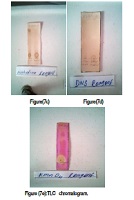Physico-Chemical Evaluation for Allium hookeri Thw. Enum Leaves
Keywords:
Allium hookeri leaf, phyto physico-chemical evaluation., antioxidant, anti-inflammatoryAbstract
Awareness and general acceptability of the natural products is increasing day by day because of its lesser side effect and cost factor. Above 80% of the world population is depending upon herbal medicines. Use of plants as medicine is the oldest practice that has been used in all countries from ancient time. Based on those old practices medicines of modern days are derived either directly or indirectly from the natural products. Manipur is one of the north eastern states of India and one of the hot spot areas of biodiversity, blessed with the amazing variety of flora and fauna. Allium hookeri belongs to Alliaceae family and is a perennial herb growing in dampy soil in every kitchen garden in Manipur. It is locally known as Maroi Napakpi and used as spice and condiment in almost all Manipuri dishes. Its taste is preferred over onion in Manipur.Fresh leaves and fibrous roots are used as medicine in reducing temperature, in swelling as an antimicrobial and antioxidant and reducing blood cholesterol etc. It is reported that its root has antioxidant, free radical scavenging, antimicrobial and anti-inflammatory action. In Manipur people are taking fresh green leaves for many ailments like reducing temperature, reducing blood cholesterol, etc.. So the present study has been carried out to evaluate pharmacognostic and physicochemical analysis of shade dried leaves of Allium hookeri.. The reported information will provide data which will be useful in proper identification and authentification of this plant for future research work.
References
. The wealth of India Raw materials vol 3 ;D-E National Institute of science and communication and Information Resources Council of scientific and Industrial reserch New Delhi India; 2006 pg 174
. Bae G, Yand Bae DY. The anti inflammatory effect of ethanol extract of Allium hookeri cultivated in south Korea Korean J of Herbology (2012) 27;55;61
. Kim et al anti inflammatory effect of Allium hoookeri methanol extract in LPS induced RAW 264 .7 cells J Korean Soc food Sci Nutri 41 (11) p145-148 (2012)
. Ayam VS, Allium hookeri Th. Enum . A lesser known terrestrial perennial herb used as food and its ethnobotanical relevance in Manipur Afr.J.Food Agric. Nutri. Dev .11 (2011), 5389-5412
. Guan ZJ, zhang Guan KY Hu H. Leaf anatomical structure of pahphiopedilumand cypripedium and their adaptive significance Journal of plant research (2010) 124;289-298.
. Database in medicinal plants used in Ayurveda KV. Bilore et al vol 7 New Delhi CCRAS 2005 pg 315
. Devi LD, Allium hookeri ( Maroi napakpi) In; Folklore Medicine of ethnobiological Importance in Manipur (1990) 1st edition vol 1
. WHO,Quality control methods for medicinal plant materials WHO Geneva Switzerland (2008).
. HOOKER JD Allium hookeri I n flora of Brish India Publication Bishen and Mahindra pal Singh 1978 vol vi; 341Stackler,
. Sinha SC. Medicinal of Manipur 1996
. Bira Kumar and RC Sundriyal common species and their use in traditional system of ethnic groups of Manipur stater Indian Journal of Traditional Knowledge (2003)vol 2 p 159-169
. Bonati A How and why should we standardise phyto-pharmaceutical drugs for clinical validation J.Ethnopharmacol.(1991) 32 (1-3) 195-197
. Kim S, Kim DB, Lee S, Park J,Shin D, Yoo M. Profiling of organo sulfur compounds using HPLC-PDA and GC-MS System and antioxidant activities in hooker chives (Allium hookeri) Korean J of Food and Nutri vol 28 ( 2016) Issue 2 2015 295- 301



